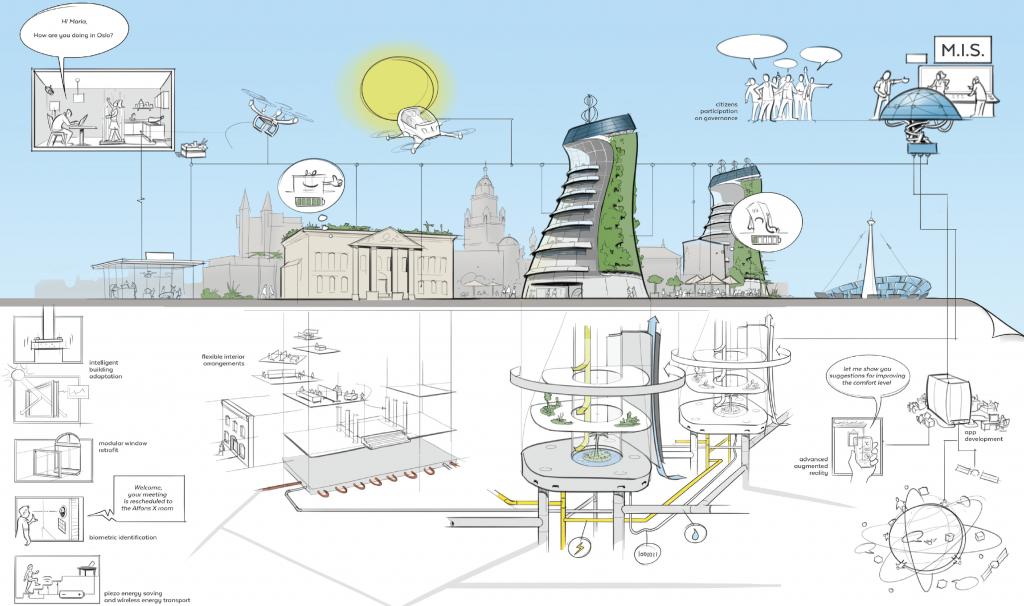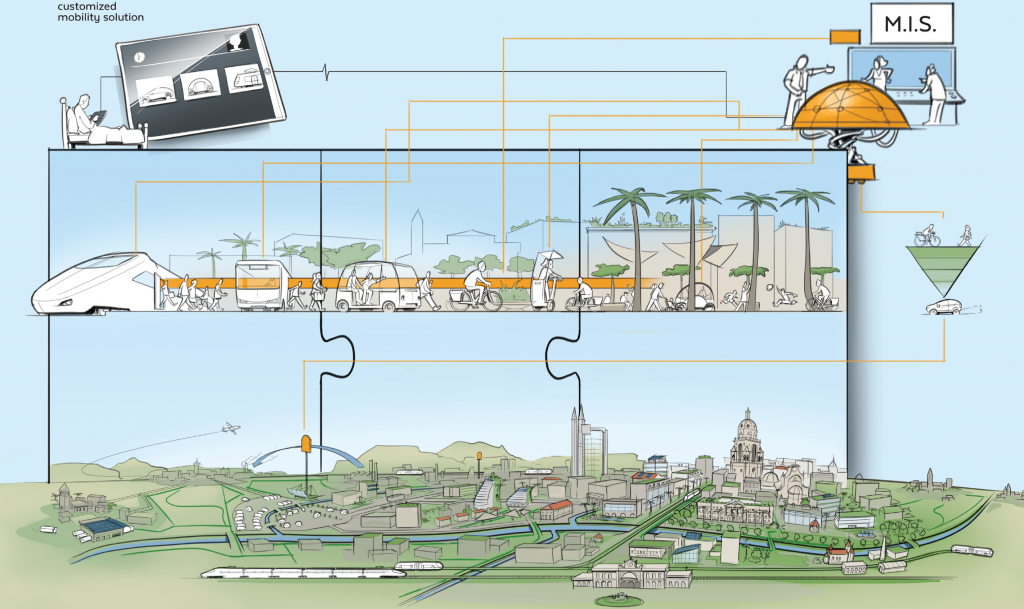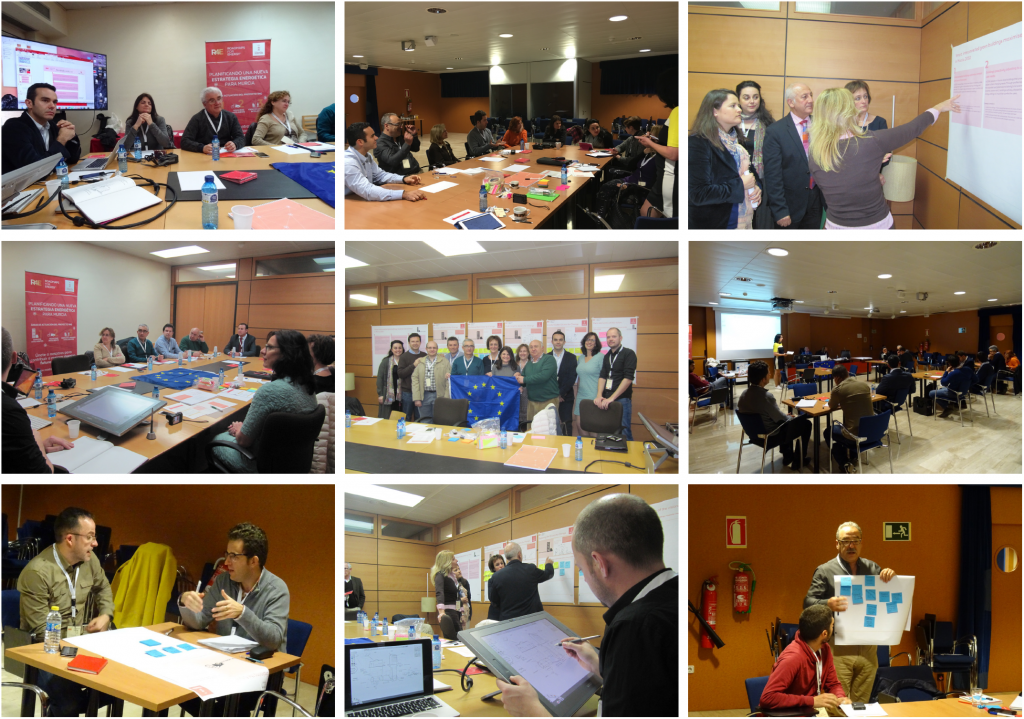Murcia Vision Development 2050

Vision development for Murcia 2050
The R4E project has completed the “Vision development” stage, which consisted of designing the services and characteristics that our cities should offer in the year 2050, based on the opinions and contributions of municipal experts of each city, their stakeholders, politicians and municipal managers. To better illustrate the process, images have been created that reflect the way our cities could look in 2050, including the services and characteristics agreed upon in the workshops for each of the project’s focus areas.
SMART, INTERCONNECTED GREEN BUILDINGS MAXIMISE USER COMFORT IN MURCIA 2050
In 2050, the people of Murcia enjoy buildings that proactively adjust to their changing needs. Through profiles based on the expected use (presence and activities) and external factors (weather, season etc.), buildings actively choose the optimum energy settings to maximise comfort for users.
The buildings are interconnected by a telemanagement system that enables sharing of energy and resources. This makes a big contribution to users’ comfort and convenience, both inside and outside the buildings.
Murcia achieved a position among Europe’s top ‘clean & green’ cities by green urban planning that values CO2-neutral energy-producing buildings. The buildings use renewable energy sources and have a low impact on nature, both during construction and in everyday use.
What characterises the city of Murcia in the focus areas of Smart Mobility and Smart Buildings and the elements of the desired future scenario are:
1. A flexible use of buildings
The buildings in Murcia facilitate highly flexible use, for different users, different activities and in different seasons. Walls, installations and furniture can be rearranged easily — for example using flexible partitioners, changeable windows or ‘floating’ desks. Standardised protocols enable roaming profiles for user settings in the virtual space. Smart management systems support effective and efficient use of the workspaces.
2. Enhancing working & family life
The buildings recognise people and can adapt to their personal preferences and habits by providing the desired atmosphere and climate settings. Homes cater for teleworking and remote healthcare through good connectivity and smart appliances. Use of the latest technologies facilitates a whole range of other activities — for example using augmented reality for easy enjoyable shopping, navigation and other everyday tasks.
3. ‘Green’ buildings technologies
The latest technologies are used in the buildings for easy energy saving, generation and storage. Examples are the use of energy-absorbing materials, and light tubes to bring daylight into the heart of the building. The buildings are climate-proof, so they can absorb heavy rain showers. And they are resistant to earth-quakes through the use of innovative solutions like flexible materials and active bumpers. Wireless networks are used to charge energy-efficient appliances.
4. Learning buildings
The buildings are interconnected: not only do they learn during use, but they can also share their learnings. The use of all utilities (energy, water, waste and other resources) is monitored. Patterns of use are recognised so upcoming activities can be anticipated, providing maximum comfort for users. This active data sharing allows the buildings to learn from each other, providing maximum user comfort at the lowest energy consumption.
5. Master Intelligent System
Murcia’s Master Intelligent System uses open data and standard protocols all over the city, providing new services on an open platform. People can easily access and connect to the platform, wherever they are. Energy supply and demand are matched — and legally embedded — in the central system. The focus is on the users’ needs, with priority for emergency services when necessary. Energy can be exchanged freely between users, appliances, vehicles and buildings.
SAFE, CLEAN AND AFFORDABLE MOBILITY IN MURCIA 2050
In 2050, people in the Murcia region enjoy a safe and clean city, with green and healthy areas and safe and clean mobility solutions. Personal mobility needs are met and healthy mobility, such as walking and cycling, co-exists in harmony with other safe, clean forms of (shared) mobility. The public transport system is clean and effective throughout the city region, with ‘one-click’ accessibility enabled by a master intelligent system.
The design of public space and services and the availability of a wide range of mobility options ‘nudges’ people towards more sustainable and healthy lifestyles. The flexibility of personal choices is met by a system of different, interconnecting mobility modes, reflecting the differences in needs and possible solutions throughout the city and region. Urban spaces are designed with a focus on people. Those from the outlying areas and visitors are provided with clean, fast accessibility to the city centre. It is easy for people to move around near the centre with services to meet their daily needs. The down-town area is a safe and pleasant place for pedestrians.
1. All people’s avenue
The down-town area is a safe and pleasant place for pedestrians. Public spaces are designed for them and traffic is restricted to emergencies, residents and public services. Urban spaces such as an ‘all people’s avenue’ are pleasant, comfortable, quiet, green, shady and accessible for all. These spaces are shared with bikes and one-person e-cars.
2. Urban liveability
The ‘urban zone’ is a place where people can easily move around, with good access to the city as well as the outlying areas. Industrial estates and warehouses are moved from the urban areas to the outskirts, freeing space for sustainable transport, such as trams, electric buses, clean private cars and a public car-sharing system. De-centralised services are provided to meet daily needs, and there are green lanes for long-distance walking and cycling.
3. Connecting people
The ‘pedanías’ zone provides accessibility for people from the outlying areas and visitors. (Mass) public transport is provided by train, tram and bus, and is clean, fast and accessible. Free parking for private (unsustain-able) cars is available at inter-modal transport hubs. These make it easy for people and goods to switch between different mobility means, encouraging sustainable choices. Easy access to the countryside revalues country lifestyle and products.
4. Smart citizens
Citizens naturally choose sustainable and healthy solutions. Mentality and behaviour embrace healthy living. People value a clean and safe city, and are willing to contribute to achieving this. Education from an early age and co-creative workshops with citizens and companies, increase awareness and involvement, and challenge people to participate actively in new ‘mobility plans’.
5. Master Intelligent System
An intelligent global system integrates mobility modes and allows users to enjoy ‘mobility à la carte’. A ‘one-click’ system pro-actively adjusts to people’s profiles and needs, based on up-to-date information and forecasts. The system is easily accessible with one profile for reservations, payments and information. Controlling incentives avoid misuse and keep the system free of undesired side-effects.
All these ideas and input have emerged from the participatory workshops that have taken place in the city of Murcia and whose images can be seen below:



Leave a Comment